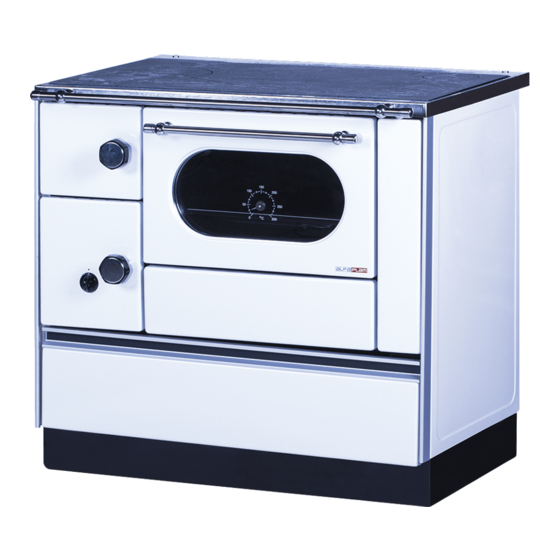Subscribe to Our Youtube Channel
Summary of Contents for Alfa Plam KMS 70 FAVORIT
- Page 1 Figure 1 Solid fuel cook-stove KMŠ 70 and KVŠ 90H 1. Fire box door 2. Ash pan door 3. Air inlet control 4. Fuel drawer 5. Side flue gas connector 6. Oven door with double glass 7. Protective cover for cleaning opening (insulated)
- Page 2 INSTRUCTION FOR INSTALLATION, USE AND HANDLING This instruction for installation, use and handling apply for the following types of cook- stoves: KMŠ 70 FAVORIT, KMŠ 70 STANDARD, KMŠ 70 TERMO KVŠ 90H FAVORIT, KVŠ 90H STANDARD, KVŠ 90H TERMO Generally, regulations on firing must be observed, both local and applicable local, national and European norms and regulations.
-
Page 3: Technical Characteristics
1. TECHNICAL CHARACTERISTICS ------------------------------------------------------------------------ UNIT KMŠ 70 KVŠ 90H ------------------------------------------------------------------------------ Nominal heating capacity (kW) --------------------------------------------------------------------------------------------------------------------- Waste gas mass flow (g/s) 10.7 for chopped wood 10.2 for chopped wood 9.9 for brown coal briquette 9.2 for brown coal briquette -------------------------------------------------------------------------------------------------- Waste gas temperature (°... - Page 4 distance of incorporated parts made of combustible materials from charging opening to lateral sides must be minimum 80 cm. Safety clearance to objects that should be protected (combustible walls, walls containing combustible building blocks, kitchen closets and steel concrete bearing walls) should be no less than 20 cm, and 30 cm laterally.
-
Page 5: Air Flow Control
3. HANDLING FIRE DOOR HANDLE In case that firebox door handle gets too hot, door closing and opening is only possible with special key from the existing accessories (Figure 2, Item 8). Figure 2 AIR FLOW CONTROL Figure 3 PRIMARY AIR Primary air for combustion, and thereby heating capacity of cook-stove, is determined with primary combustion air. -
Page 6: Secondary Air
Note: In order to prevent cook-stove overheating, quantity of fuel must not be larger than 1.8 kg of dry wood or 1.7 kg of brown coal briquette per hour with corresponding combustion air setting. 3.2.2 SECONDARY AIR With secondary air supply (Figure 4, from above, over the fuel, flow of combustion air) to the fuel which is used, combustion with minimum harmless substances is achieved. - Page 7 Heating flap is operated when button (Figure 5, Item 11) located above the oven door is actuated. This button is used to shorten the ways of flue gases during firing. Heating flap should be opened only in the stage of stove kindling. During firing, open heating flap causes stove overheating and hence the damages of stove parts.
- Page 8 corrosion protection coating may develop obnoxious but insignificant smoke. This is normal and disappears after short time. Take into consideration that some integral parts of the cook-stove (exhaust gas pipe, charging door etc.), when the cook-stove is lit, may be hot and present danger of burns. Special attention to safety should be paid, especially where children are present.
- Page 9 For KVŠ 90H cook-stove: Fuel Fuel quantity Burning time Primary air Secondary air setting setting Chopped wood 1.8 kg 1.0 h Rate 1 2 short wood logs Brown coal 3.3 kg 2.0 h Rate 1.5 briquette 6 whole briquettes Take care not to feed more wood or brown coal briquette than needed for nominal heating capacity.
- Page 10 In inclined position, shaking grate arm is removed and after that shaking grate is pulled out through the charging opening. Then shaking grate support is lifted and pulled out. After that, integral parts of the grate can be positioned, in reverse order, in the upper position. In the upper recess, shaking grate arm shall be moved to the cook-stove front and lifted through ash compartment in such a way that grate tooth is locked in the opening on shaking grate arm.
-
Page 11: Cleaning Opening
FIRING IN TRANSITIONAL PERIODS At outside temperatures above 15°C, due to small transport pressure, small fire occurs in chimney thus creating more soot in cook-stove flueways and masonry chimney. Increase primary air supply, stoke fire more often, and add smaller pieces of chopped wood more often in order to decrease soot formation in transitional periods. -
Page 12: General Notes
A cover is located behind the protective cover of cleaning opening (Figure 6, Item 12). It is fixed with one thumb-lock on the front of the stove and must be removed in order to enable cleaning the cook-stove interior. Before the cover is again fixed with screws, sealing braid located at the cover should be checked for good sealing and, if needed, replaced.











Need help?
Do you have a question about the KMS 70 FAVORIT and is the answer not in the manual?
Questions and answers